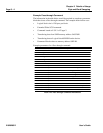
21020285 D User’s Guide
Chapter 8 Details of Usage
Page 8 - 10 Tagged Queuing
Notes on
Usage
The following provides additional detail about how tagged queuing works for
the RF3880.
Queue Tag Numbers
• The RF3880 will never have duplicate queue tag numbers assigned at the
same time to any single device.
• The maximum number out to a device at one time will be 255.
• If all 255 tag numbers have been assigned to commands, the RF3880
simply waits for previous commands to complete before sending any
more tagged commands to that device.
Queue Full Status
• If a device reports Queue Full status before it has received all possible
255 commands, the RF3880 sets an internal threshold flag,
(MAXIMUM_COMMANDS) equal to the number of commands out at
the time of the Queue Full status.
• The command that generated the Queue Full status will once more be sent
out to the device when the number of commands out to the device drops
below the threshold set in MAXIMUM_COMMANDS. (One or more
disconnected commands complete). This cuts down on unnecessary SCSI
bus activity.
• Once below the MAXIMUM_COMMANDS threshold, additional
commands will continue to be sent to the SCSI device until another Queue
Full status is reported, at which time the MAXIMUM_COMMANDS
threshold is set again.
Message Reject
• On the initial command to a SCSI device for which tagged queuing has
been enabled, the adapter verifies that the device accepted the queue tag
message.
• If the device rejects the queue tag message, the RF3880 does not send
further queue tag messages in order to avoid unnecessary SCSI bus
activity.
• In the case of a message reject of a tag message, no error is reported to
the host.
Tagged Queuing Statistics
The Extended Board Statistics command (16H) returns two fields, per target,
that may be useful in evaluating the performance of tagged queuing with a
SCSI-2 or SCSI-3 device. The fields are: Queue Full Count and Maximum
Queued. See Chapter 7 for details.


















